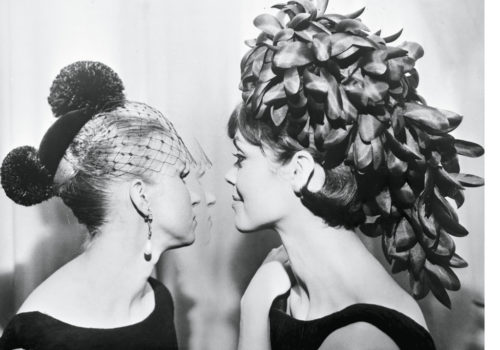The hats of Parisian milliner Madame Paulette have appeared in countless scenes over time. From the 1940 through the 80s, Paulette’s works sat perched atop the likes of everyone from Gloria Swanson to Rose Kennedy, Eva Péron to Princess Grace of Monaco. Designing for everyone from Pierre Balmain to Coco Chanel throughout her career, Paulette worked well into her 80s for the likes of Thierry Mugler and Claude Montana. Chic is the word.
Madame Paulette understood how to crown the female form, attracting the eye of the great photographers of her time. Photographs by Cecil Beaton, Richard Avedon, Bill Brandt Horst P. Horst, Helmut Newton, Guy Bourdin, and William Klein have been festooned and adorned by the inspired creations of Madame. When taken together as a collection, the result is a story that is as delightful as it is magnificent.
Hats by Madame Paulette: Paris Milliner Extraordinaire by Annie Schneider (Thames & Hudson) is an elegant collection of photographs illustrating the life’s work of the “Queen among milliners.” From toques, capelines and boaters to pillboxes, and evening caps, Paulette’s creations are breathtaking inventions, each more fantastical than the next, a personality awaiting a person. Combined with models, actors, royalty, each hat and wearer came together in harmony before the camera captured them together forever more.
Once upon a time, as Schneider writes, “No woman could go out without a hat or else she would be en cheveux (“wearing her hair”), as it was called. Hats were worn at the races, at cocktail parties and soirées, and in particular at restaurants, where they were especially important. As Paulette was constantly repeating: ‘At the dining table, the women are all hats and jewelry!’”
High society crowned itself and celebrated in grand style as Robert Doisneau’s photographs of “the party of the century” reveal. As Schneider notes, this was “the ball thrown by the flamboyant, multimillionaire art collector Carlos de Beistegui at Palazzo Labia in Venice in 1951. The costumes worn by the four hundred guests, who had come from all over Europe, were inspired by the paintings and wall hangings from the eighteenth century: the revelers looked as if they had stepped out of the Tiepolo frescoes decorating the palace walls. In the middle of the night, the guests, dressed in their splendid costumes, went out and mingled with the ordinary Venetians who had gathered in the piazza outside the palace. The ball continued like this in an atmosphere of dizzying gaiety until daybreak.”
It is in the retelling of history, that we pay respect to a style of devastating grandeur, a richness of expression that has become a thing of the past, a thing of classic black and white photographs of the ruling class. We see Wallis Simpson at the funeral of the Duke of Windsor in 1972, wearing a black organza veil of the utmost discretion. Madame Paulette was exceedingly delicate with the notoriously particular, narcissistic, and complicated Duchess. The result was remarkable.
And so it is that we begin to understand, in photograph after photograph, the relationship between hat, milliner, and patron. It is a relationship established over a series of fittings, a conversation that becomes something more, something that exists when the hat works its magic on the eye. It is by virtue of the photograph that we can forever enjoy something as remarkable as in its distinctiveness are the hats of Madame Paulette.
http://thamesandhudsonusa.com/books/hats-by-madame-paulette-hardcover
http://missrosen.wordpress.com
















